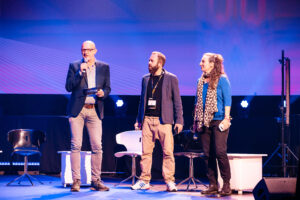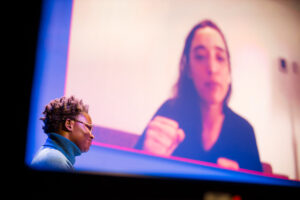Most Wanted: Music
News
content-full.php
Most Wanted: Music 2021 – Recap
- The eighth MW:M conference saw three days of exciting activity at its Kulturbrauerei hub, with online speakers and attendees also joining in from around the world
- A bustling on-site and online event: 75 sessions, 20 satellite events, and 170 speakers over 6 stages
- Everything debated at MW:M21 was designed to initiate change: emerging technology shifting power to artists, community actions that amplify BIPOC voices, and practical ways to create sustainable businesses
The MW:M21 conference welcomed back attendees, whereby three public venues buzzed with excitement and activity, and a global online audience hopped between dozens of streams from real-world and online-only stages. “Change” was the spark that initiated all of the sessions: experts from all over the globe led panels, debates, workshops, and discussions – all designed to initiate actions that build a more positive future for the music industry.
“We had around 2,000 registered participants over the three days on-site at the Kulturbrauerei and online across the various events. 1,300 users used the digital conference platform, which is an increas
© Florian Reimann
HIGHLIGHTS – Impact:
the most consequential ideas
The conference began with an inspirational keynote talk from Michela Magas, Innovation Advisor to the European Commission, who passionately demonstrated how music, creativity and technological innovation unite in the music industry: “music is our social glue, and the diversity of our community is paramount. Whenever we’re asked what will happen we always say, ‘we don’t predict the future… we invent it.’
Music generated by non-humans will have positive effects on a human level, argued Rihanna and Kanye West producer Keyon Christ, who is excited by the societal possibilities prompted by “hearing the diversity of ethnic voices on something AI-generated,” during his work with the Dadabots AI collective. “What happens when we can mix together voices from a variety of continents?” He also teased the results of the collaboration: “We’re super-focused on creating the future of sound… I can’t wait for you guys to hear it.”
Any changes in how artists generate money are profound, and direct-to-fan relationships are quietly revolutionary. In a session dissecting independent artists’ income streams, Mike Darlington, CEO of Monstercat, said that, “it might be controversial, but record labels are not necessary any more – you can build the community and the audience yourself.”
HIGHLIGHTS – Experience:
new ways music affects us
HIGHLIGHTS – Transform:
empowering real change
The “Amplifying BIPOC Voices in the Music Industry” session found the panel in agreement: actions are still not speaking louder than words. Christine Kakaire of Black Artist Database warned against being “distracted by performative messages,” suggesting we ask instead, “what are the actions taking place? That’s where the change happens.” Femi Oyewole of Black Brown Berlin agreed, saying it was vital to challenge creative and music businesses whose messaging does not match their actual diversity.
The decentralising effects of NFTs are often expressed in financial terms, but Michail Stangl of the open-source NFT/Web3 protocol Zora expressed excitement about the societal effects of a Web3 “solidarity economy,” which could bring fairer representation within the resulting ecosystem. Back in the Hybrid Music Lab, award-winning musician Terra Naomi – also community manager at NFT platform Async Art – explained how by re-releasing her hit song “Say It’s Possible” as an NFT, she, “generated more revenue in one week than Universal Music made from it in 15 years.”
© Stefan WIeland
In the closing keynote, highly respected DJ Sama’ Abdulhadi reflected on her life in techno and the powerful communities in it, saying: “Techno has always been about standing with minorities.” Sama’ celebrated the peace that these communities have fostered: “We live in this crazy world, but when you go to a festival it is another reality. People are pure and you feel comfortable in a free space. That should be what the world is like.”
MW:M Live, the listen to berlin:
Awards, and Satellite events
The recordings of the panels will soon be made available on the Most Wanted: Music YouTube channel. Looking ahead, Most Wanted: Music 2022 will take place in the second week of November at the Kulturbrauerei.



